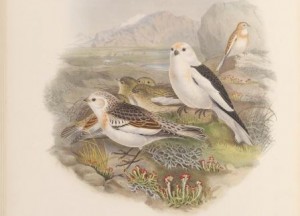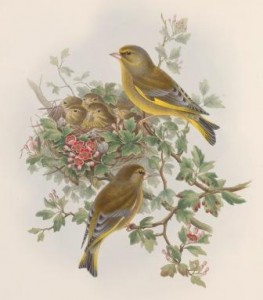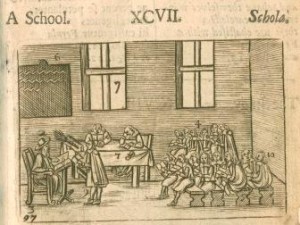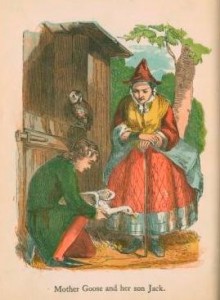November 30, 2011, by C Fawcett
Book illustrations in Briggs and Porter Collections
Recent increasing use of our rare book collections has highlighted their potential for the study of book illustration. The collections offer a wide variety of illustration, from early woodcuts and engravings, to chromo-lithographs and photographs. Illustrative material is not always identified in catalogue entries, but two collections, the Briggs Collection of Children’s Educational Literature, and the Porter Collection of ornithological books are particularly rich in this respect.
There are almost 2000 books in the Briggs Collection, which mainly date from the 17th to the mid-19th century, and typically contain simple woodcuts and engravings designed to embellish the text, and catch children’s interest.
An early example of a child’s picture book was Orbis sensualium pictus by Johannes Amos Comenius (1592-1670). He was one of the first educators to see the value of illustration in children’s textbooks, and to use pictures as an aid to learning. His approach was widely copied.
In other books, the illustrations serve a purely decorative function. As new printing techniques reduced the cost of colour printing, children’s books were increasingly enhanced by vivid pictures. Readers of Favourite pleasure books for young people (published in 1859) were told that its illustrations “were printed in colours from a succession of engraved wood-blocks, at a machine worked by steam”.
Then as now, when the illustrations were uncoloured, children often took the opportunity to practise their artistic skills by colouring them themselves. There are some engaging examples of this in the collection.

Snow bunting, from John Gould’s “The birds of Great Britain”, 1873.Porter Collection, osXX QL690.G7 GOU
In contrast to these simple and usually cheap illustrations typical of children’s books in the 19th century, the Porter Collection of ornithological books holds examples of the highest quality images. Bird illustration is a specialised art form; in addition to absolute accuracy, the artist was also expected to show some characteristic or habit of the bird. The illustrations were therefore of real scientific value, complementing the text to show the subjects’ colouring, plumage, and environment. Photo-gravure and lithographic technology were used to reproduce the drawings in print, and the colour was added afterwards by hand.

Greenfinch, from John Gould’s “The birds of Great Britain”, 1873.Porter Collection, osXX QL690.G7 GOU
The works by John Gould (1804-1881) are an outstanding example. During his lifetime Gould published around fifty folio volumes on birds of the world, introducing exotic species to an eager public audience. The books were aimed at the top of the market; large format, with beautiful colour plates, they were expensive to produce, and beyond the pocket of the ordinary man or woman. Many were published by subscription, and adorned the libraries of the well-to-do.
The Porter Collection holds a number of Gould’s works, together with a range of other ornithological works dating from the late 18th century to the mid 20th, and featuring the work of artists such as A.W. Seaby, Archibald Thorburn, D.M. Reid Henry, Lilian Medland, H. Grönvold, and many more. It is a wonderful collection for researchers into natural history illustration.



[…] of a robin features in one of about 650 ornithological books that form part of the University’s Porter Collection. Out of all the birds in the extensive collection, the robin is by far the most heavily associated […]
[…] for the amusement and instruction of all young people at Christmas. As with other items in the Briggs Collection, its cover illustrates the 19th century use of decorated bindings to add appeal for young […]
[…] seasonable matter, in prose and verse, in which the song appears, is housed in the University’s Briggs Collection of Educational […]
I have an attractive children’s book called ‘Little Toddles & his Playmates’ The authors are Mrs M J Tilsley and Aunt Fanny. It is published by Dean and son of London. The board cover is illustrated in green and black on blue and all the pages within are illustrated with 32 chromo prints. I do not have the date of publication, but the inside dedication page is to Spencer Smith on his 8th Birthday – January 21st 1888. Spencer was my great uncle.
I am considering selling the book, but have no idea of it’s value, or I might donate it where it can be appreciated. Dean’s chromo toy books ‘ have been specially designed and are printed in the best and most artistic manner in eight to twelve different colours. No book in all the series contains anything approaching vulgarity – .. to furnish amusement , coupled with refinement, for our dear little ones’
I would appreciate an e-mail response
Mrs Pilkinton, I have passed on your comment to the Special Collections Librarian, who will be in touch.